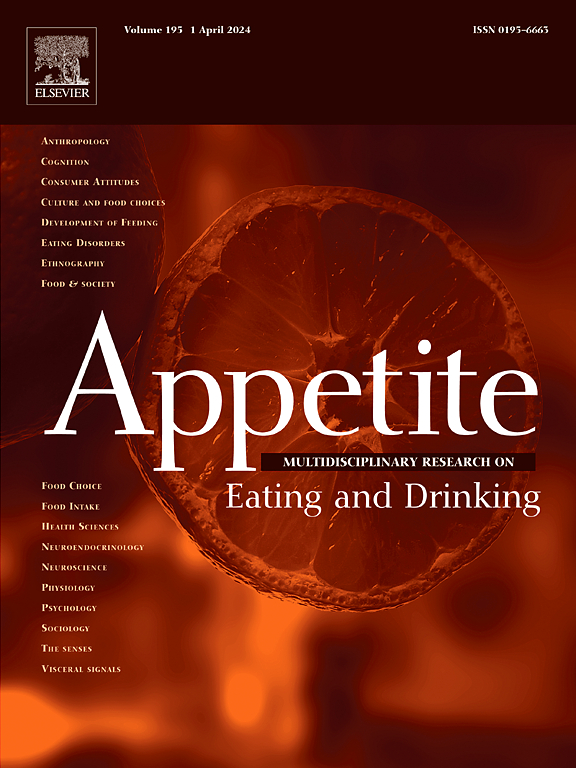A narrative review of public and expert perceptions of ultra-processed foods: Knowledge, opinions, and educational directions
IF 3.8
2区 医学
Q1 BEHAVIORAL SCIENCES
引用次数: 0
Abstract
Ultra-processed foods (UPFs; e.g., packaged salty snacks, packaged desserts, soda), “Group 4” foods of the NOVA classification system, are tasty, readily available, convenient, affordable, and rewarding. However, UPFs have been linked to numerous physical and mental health consequences, such as overweight/obesity and depression. Despite UPFs garnering attention as a public health concern and the NOVA system becoming more heavily researched, there remains some uncertainty about UPFs, including how to apply the NOVA classification system to identify UPFs and the pros and cons of UPFs in our environment. Public health initiatives focused on UPFs will likely need to involve educational efforts to fill knowledge gaps, but it is important to first understand population-wide perspectives of UPFs. This narrative review examines literature published in the past 10 years and explores knowledge and perceptions of UPFs among general population samples, expert populations (nutrition experts), and niche populations (children, athletes, and university students/staff). While this review finds that many are aware of UPFs and perceive them as unhealthy, misidentification commonly occurs for specific UPFs (i.e., breads, granola) possibly because these products are viewed as healthier foods. Based on the research available, we do not have a clear global understanding about knowledge and perceptions of UPFs. This review also discusses how educational initiatives, such as school-based education or gamification, may be utilized to fill knowledge gaps to empower consumers to make informed consumption choices.
公众和专家对超加工食品的看法:知识、意见和教育方向
超加工食品(upf,如包装咸味零食、包装甜点、苏打水)是NOVA分类系统的“第4组”食品,美味、易得、方便、价格合理、有益。然而,upf与许多身心健康后果有关,例如超重/肥胖和抑郁。尽管upf作为一个公共健康问题引起了人们的关注,NOVA系统也得到了越来越多的研究,但关于upf仍然存在一些不确定性,包括如何应用NOVA分类系统来识别upf以及upf在我们环境中的优缺点。以普遍适用方案为重点的公共卫生行动可能需要包括教育工作,以填补知识空白,但重要的是首先要了解普遍适用方案在全民范围内的观点。这篇叙述性综述研究了过去10年发表的文献,并探讨了普通人群样本、专家人群(营养专家)和利基人群(儿童、运动员和大学生/教职员工)对upf的认识和看法。虽然这次审查发现许多人都知道upf,并认为它们不健康,但通常会对特定的upf(即面包、格兰诺拉麦片)发生错误识别,可能是因为这些产品被视为更健康的食品。根据现有的研究,我们对upf的知识和看法没有一个清晰的全球理解。本综述还讨论了如何利用学校教育或游戏化等教育举措来填补知识空白,从而使消费者能够做出明智的消费选择。
本文章由计算机程序翻译,如有差异,请以英文原文为准。
求助全文
约1分钟内获得全文
求助全文
来源期刊

Appetite
医学-行为科学
CiteScore
9.10
自引率
11.10%
发文量
566
审稿时长
13.4 weeks
期刊介绍:
Appetite is an international research journal specializing in cultural, social, psychological, sensory and physiological influences on the selection and intake of foods and drinks. It covers normal and disordered eating and drinking and welcomes studies of both human and non-human animal behaviour toward food. Appetite publishes research reports, reviews and commentaries. Thematic special issues appear regularly. From time to time the journal carries abstracts from professional meetings. Submissions to Appetite are expected to be based primarily on observations directly related to the selection and intake of foods and drinks; papers that are primarily focused on topics such as nutrition or obesity will not be considered unless they specifically make a novel scientific contribution to the understanding of appetite in line with the journal's aims and scope.
 求助内容:
求助内容: 应助结果提醒方式:
应助结果提醒方式:


